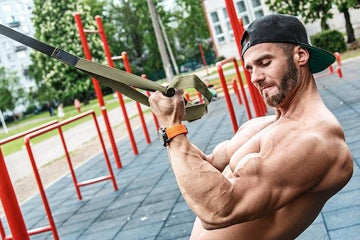

Strength Unchained: A Simple Way to Get Stronger, Faster
Table of Contents
Strength Unchained: A Simple Way to Get Stronger, Faster
Reprinted from Musclemedia Magazine
By: Christian Finn
Think back to the last time you hit failure on the bench press. If you’re anything like most people, chances are that you failed somewhere near the bottom of the movement, with the bar next to your chest. If your training partner helps you get the bar off your chest and past the sticking point, you can normally finish the exercise on your own steam. That’s because the bench press is an exercise with an ascending strength curve, which means you’re stronger in the top part of the exercise than you are at the bottom.
What if there was a way to make the bar lighter at the bottom of the movement and heavier at the top? This would allow you to overload the muscles at the top of the exercise, where they normally do less work than at the bottom. In other words, you want to modify the amount of weight on the bar during the set itself. But that’s impossible, right? Not if you have a couple of chains it isn’t.
Imagine a barbell with some regular plates and a couple of heavy chains hanging from each end. As you lower the barbell towards your chest during the bench press, some of the links in the chain gather on the ground. This has the effect of making the bar lighter. Then, when you press the bar back to the starting position, each link of the chain is pulled from the floor. The result? The weight you’re lifting gets heavier. The same thing happens with the squat. As you descend into a squat, some of the links in the chain gather on the floor. This makes the barbell lighter. As you push up out of the squat, more of the chain comes off the floor. This increases the weight of the bar, which means that your muscles have to do more work to finish the lift.
Elastic bands work in much the same way. One end is anchored to the floor, while the other end is attached to the bar. As you lift the weight, the bands stretch, which increases the resistance at the top of the movement. At the point in the exercise where you’re strongest, the weight is at its heaviest. Conversely, the weight is at its lightest in the part of the exercise where you’re weakest. If you can use as much weight as possible in the upper phase of the exercise while still training through a full range of motion, you can achieve a much higher level of muscle tension throughout the entire movement. All of which should translate – in theory anyway – into greater strength gains.
Bands and chains have become increasingly popular in the powerlifting community after their use was popularized by Louie Simmons of Westside Barbell in the 1990’s. In a survey of 32 elite British powerlifters, 6 out of 10 lifters incorporated chains in their training, while 4 out of 10 preferred the use of elastic bands . But it’s only in recent years that researchers have put bands and chains to the test. In one trial, researchers from New York’s Ithaca University divided male and female athletes into two groups .
One group used elastic bands on the bench press and squat, while the second group trained without them. All the athletes trained three times a week, working the upper and lower body on consecutive days. Sets (3-6), repetitions (2–10), and weight (72–98% 1RM) were periodized in a wavelike fashion during the study. After seven weeks, both groups got stronger. But it was the group using the elastic bands that got the best results. In the bench press, the group training with bands made twice the gains of those training without them. In the squat, the elastic band group improved almost three times faster than the control group.
References:
1. Anderson CE, Sforzo GA, Sigg JA. (2008). The effects of combining elastic and free weight resistance on strength and power in athletes. Journal of Strength and Conditioning Research, 22, 567-574
2. Ghigiarelli JJ, Nagle EF, Gross FL, Robertson RJ, Irrgang JJ, Myslinski T. (2009). The effects of a 7-week heavy elastic band and weight chain program on upper-body strength and upper-body power in a sample of division 1-AA football players. Journal of Strength and Conditioning Research, 23, 756-764
3. Swinton, P. A., Lloyd, R., Agouris, I., & Stewart, A. (2009). Contemporary training practices in elite british powerlifters: Survey results from an international competition. Journal of Strength and Conditioning Research, 23, 380-384
MUSCLE MEDIA MAGAZINE FOR MEN
The premier source of training, nutrition, supplements, fat loss and health for men.

















